| Botanical Name |
|
| Family |
Bignoniaceae - The jacaranda family. |
| Pronunciation |
|
| Common Name(s) |
English: Cape honeysuckle
Afrikaans: Kaapse Kanferoelie
IsiXhosa: umsilingi; inkaca; Icakatha
IsiZulu: Incwincwi; Uchacha; Udodo
|
| Plant Group |
- Climber / Creeper Climber: a plant that climbs using tendrils or if given support.
Creeper: a plant running along the ground, often rooting as it goes.
- Shrub A woody plant of relatively low height, having several stems arising from the base and lacking a single trunk; a bush.
|
| Plant Size |
- Medium to Large
| Tree | 15m to 20m |
| Shrub | 2m to 3m |
| Perennial/ground cover | 60cm to 75cm |
| Bulb | 60cm to 1m |
| Succulent | 60cm to 1m |
|
| Position |
- Canopy Shade Canopy shade is found below closely grown trees where some light filters through. Ideal for the protection of herbaceous plants.
- Dry Shade Shady areas where soil has poor water retention or are dependent on rain for their moisture needs.
- Light or Dappled Shade Found below trees with sparse, open foliage. Ideal for the protection of herbaceous plants.
- Partial Shade The area is in shade for part of the day and in full sun for part of the day.
- Sun The area is in full sun for all or most of the day, all year round.
|
| General Information |
- Drought Tolerance: High The plant is well adapted to arid conditions; it can survive long periods of drought and high temperatures without extra water.
- Evergreen to semi-deciduous The plant is evergreen in warmer, wetter parts of the country, but may lose some of its leaves during winter in colder, drier situations.
- Frost: Half-hardy The plant is able to survive low temperatures and some frost but requires protection against severe frost.
- Prune hard after flowering Fast growing shrubs that grow lanky within a season. Cut off branches and stems of these plants to a third of their original length. This will increase the yield of flowers, improve the plants shape and enhance the structural strength of main branches.
- Water Wise Plant species originating from low rainfall regions that require less water to survive and thrive than other plant species.
- Wind Tolerant Plants able to withstand the effect of strong winds.
|
| Specific Information |
Tecoma capensis is a vigorous, rambling shrub with shiny green leaves, often seen in hedgerows along the road. It has multiple branches and often creeps along the ground, rooting as it goes. Its scrambling nature can leave it looking untidy and it can become invasive if not monitored. The shrub will grow as wide as it is tall and will scramble into any surrounding vegetation. The dense branches are an ideal nesting place for some birds and in my garden the sunbirds seem particularly fond of it for this purpose. It is the larval food for the Death's Head and Fulvous Hawkmoths.
Tecoma capensis was previously known as Tecomaria capensis.
|
| Ad Break |
|
| Flowers |
| Description |
clusters of tubular blooms at the ends of branches
|
| Season |
- All Year Plants will seldom bloom for the entire season as given in the list, but should flower during a period within these parameters.
- Autumn to Spring Plants will seldom bloom for the entire season as given in the list, but should flower during a period within these parameters.
|
| Colour |
|
| Growth Rate |
- Fast Specifying growth rate can be very misleading as there is considerable variation of growth rate depending on type and species of plant, available water, supplementary feeding, mulching and general care, as well as the plants suitability and adaptability to the garden environment.
|
| Plant Uses |
- Attracts bees, butterflies or other insects This plant attracts insects which can be food for birds or other creatures in your garden.
- Attracts Birds This plant will attract birds.
- Barrier Plant A very thorny shrub, tree or scrambler that can be used to create an impenetrable barrier.
- Boundary A plant useful for planting around the edges of the property to form a green or colourful backdrop, an impenetrable hedge, to hide walls or create privacy.
- Container Trees, shrubs and ornamental species that can adapt to growing in a restricted environment.
- Filler Either a fast growing tree or shrub used temporarily to fill in an area while the permanent plants grow to a desired size, or a plant used to fill gaps in borders or beds.
- Hedge Suitable trees or shrubs planted relatively close together so that the branches intertwine to create a barrier. This can be formal – the plants are regularly trimmed to produce a neat shape, or informal – the plants are left to themselves to create a natural hedgerow.
- Pioneer for new gardens A very fast growing plant, able to withstand hardship, that can be used to populate land that has recently been cleared of natural vegetation. These plants pave the way for slower-growing species by adding nutrients to the soil and creating leaf litter.
- Screen A tall hedge of suitable plants planted closely together and used as a windbreak, to block a bad view, to separate parts of the garden or as a backdrop.
- Stabilize Banks Plant is used to prevent soil erosion because their roots will form a mat that stabilizes the soil and keeps it from washing away in heavy rains.
- Suitable for coastal gardens Plants adapted to dry, sandy soil, forceful wind, limited rainfall and intense sunlight.
- Wild Garden An indigenous garden planted for the benefit of wildlife and birds. Provides food, water, a variety of mini-biomes and no poisonous chemicals are used.
|
| Distribution and Habitat |
from the southern part of the Western cape, along the coast through the Eastern Cape and KwaZulu-Natal, then into Mpumalanga and southern Mozambique, along stream banks, in the margins of forests and in bushveld and scrub
|
| Planting Suggestions |
Plant Tecoma capensis in well-drained soil with a good mix of compost and fertiliser, mulch well and water regularly until established. Reduce water if water is scarce. Prune back in late winter to encourage new growth and flowering. To grow Tecoma as a self-standing shrub it needs to be cut or pinched back regularly, and all ground hugging shoots should be removed.
|
| Medicinal Uses |
The powdered bark is said to relieve pain and produce sleep and is rubbed around the teeth for bleeding gums.
|
| Ad Break |
|



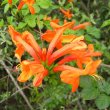
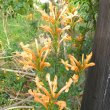
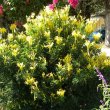
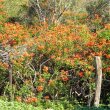
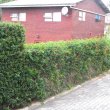
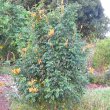


Comments
Tecoma Capensis
Can anyone provide expert advise?
I have read that Tecoma Capensis choked other plants that were planted closeby. I have planted Tecomas approximately 1.5m from Buddleja Salviifolia. Will the Buddleja be affected at all given that it will grow higher (+/- 4m) than the Capensis (+/- 2.1m)?
Tecoma capensis invasion
Hi Centurion Gardener
Yes, Tecoma can be incredibly invasive if left to its own devices. As an extreme example, I had a stand of Tecoma on my property that completely invaded an area of over 1 000 square meters of veld, to a height of 2 - 3 meters! Not even a blade of grass was able to survive under this onslaught.
In your situation the problem is not the height to which the plants will grow, but the width. Depending on the soil fertility, available moisture and climate, the Buddleja will grow to about 3 - 4 meters across, and the tecomas will each grow 2 - 3 meters across. As tecoma is a vigorous creeper, it will send shoots into the Buddleja, and may eventually smother it. Tecoma also sends ground runners 2 to 4 meters from the mother plant, rooting and growing new plants as it goes.
This said, all is not lost. Tecoma can be kept under control by timeous intervention and regular clipping. I usually cut back hard twice a year and keep a sharp lookout for runners, which I remove, whenever I am near that part of the garden.
Kind regards
Lorraine
Tecoma - removal/poisoning
We have a invasive tecoma hedge which we wannt to remove to make way for a fence. What is the most effective way of removing the hedge and what poison can you recommend for getting rid of the runners?
Thanks
Jeremy
Getting rid of tecoma
Hi Jeremy
I tried poisoning some of the tecoma I had to remove, experimenting with both Ridder and Round up. Both of these killed off most of the plant after the second attempt but I still had shoots growing again. Also, the poisoned sections still had to be dug out of the ground anyway.
It was more economical, environmentally safer, quicker and by far the most effective to cut the plants low down and dig all the roots and runners out. The roots were not very deep and we had no re-growth problems. The important thing is to ensure that the roots are thoroughly eradicated. If you are not going to do this yourself, be sure to monitor the process personally for best results.
Kind regards
Lorraine
When to plant
Which month is best to plant tecoma creepers?
Planting Tecoma
Hi Mona
You can plant Tecoma at any time. If you live in a very cold area, avoid planting during winter.
Kind regards
Lorraine
Discuss this plant
Share knowledge, ask a question or give an experience.